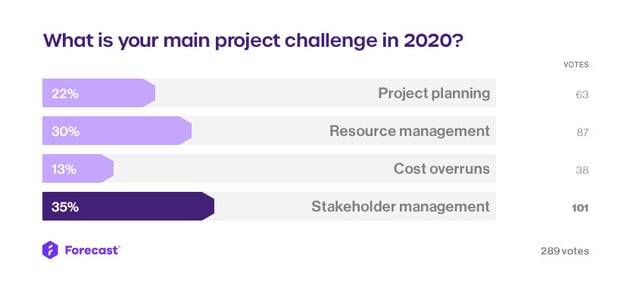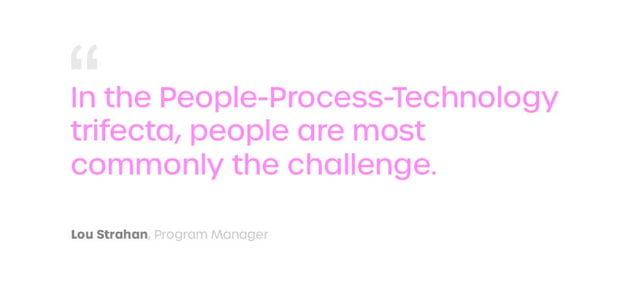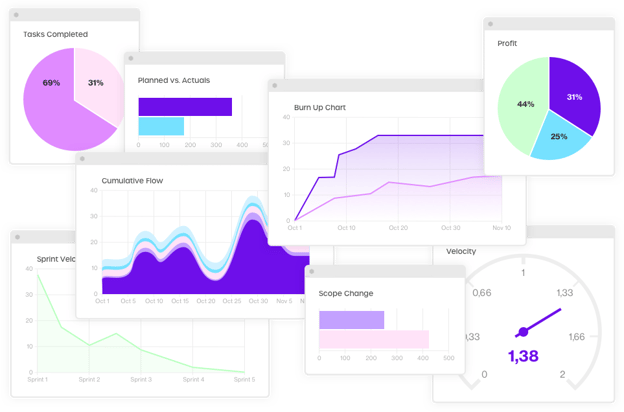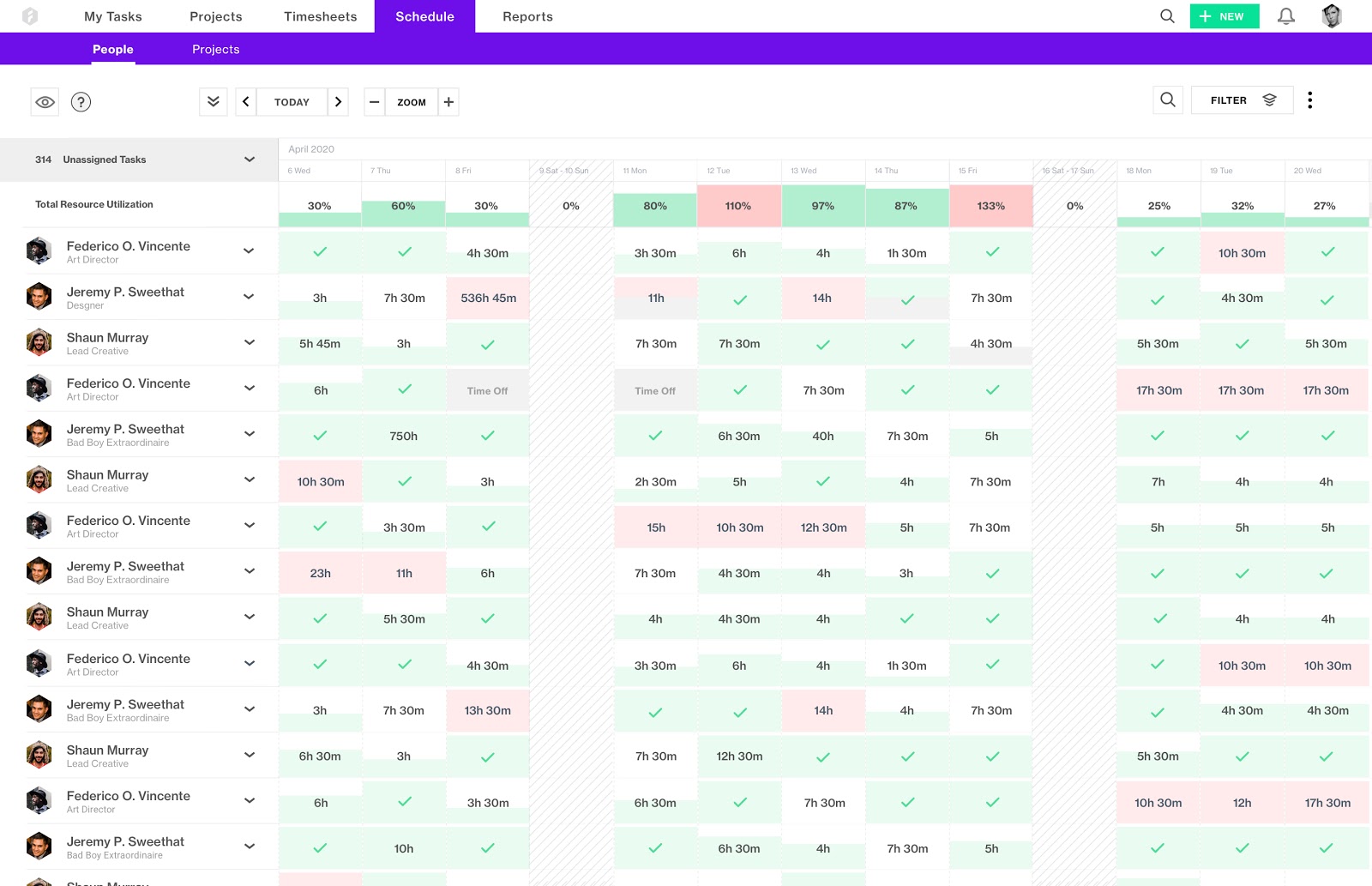280+ Project Managers Name Their Biggest Challenges of 2020

Even the most gifted and seasoned project managers face obstacles on their way to project delivery. Twenty-twenty, as no other year, has brought so much uncertainty that you could assume project management had never been more challenging.
Constantly on a mission to develop the best solutions to fine-tune project operations, we’ve carried out an independent poll to get a fresh perspective on recent challenges, asking a PMI community of project, program, and portfolio managers what has been their biggest challenge in 2020.
Choosing four widespread challenges for voting – project planning, resource management, cost overruns, and stakeholder management, we particularly wanted to know what was on top of the expert’s mind, affected by the outbreak of COVID-19 or not. In total, we’ve collected the opinions of 289 people and are happy to share them today.
This article not only sheds light on four common issues, it also presents the views of the respondents and explains why certain challenges had so much success among project managers. Can’t wait to see the results? Let’s get to them straight away.
What’s the biggest challenge of project management in 2020?
Among other outcomes, our poll makes clear that stakeholder management has been recognized as the most sweeping challenge in the community. 35% of the respondents, specifically 101 experts managing projects in different industries around the globe, gave their vote for stakeholder management, believing it should take the front seat (read on to find out why).

Not surprisingly, resource management followed with the result of 30%, supporting the facts laid out in Wellingtone’s 2019 State of Project Management that poor resource management has seen the largest increase since 2018 and is now ranked as the 2nd top challenge. Project planning had a considerable number of votes, mainly because of the COVID situation and risk that nobody accounted for.
Stakeholder management (35%)
If you’re in project management, you must be no stranger to stakeholder management and the associated pains. Second to none in our poll, it had more opinions we could hope for. When asking the respondents to explain why stakeholder management has been the toughest nut to crack, we’ve got many replies, implying that stakeholders can make a project succeed or fail.
Lou Strahan, an expert with hands-on experience in digital transformations and program management in professional services shared three stakeholder challenge observations with us:
- HiPPO Bias – Highest Paid Person's Opinions hinder the contributions of individual contributors where innovation is critical to be the norm.
- Adopt or Adapt – The balance between key stakeholders willing to adopt to industry best practices that differ from their ‘business as usual,’ versus open-minded stakeholders willing to adapt their ‘business as usual’ to ‘innovate the business.’
- Change Divergence – Change initiatives scattered across the corporate enterprise with minimal or no ‘Change Status Convergence’. What does this mean? Isolated change initiatives that are executed independently across different teams with little to no alignment to enterprise objectives and typically even fewer opportunities to share lessons learned with other teams. One derivative of this chaos is some large corporations simply dumping cash in numerous change initiatives, but few ever finding their way to adoption and monetization compared to their competitor.
In the People-Process-Technology trifecta, admits Lou, people are most commonly the challenge.

For John Sanguinetti, a veteran of Project and Program Management, the poll was a toss up between scope management and stakeholder management. According to John,
Because scope goes through a process of detail definition in the implementation of ERP Software, the more you discover and document in the definition process, the more challenges present themselves as it relates to time, budget, and resource capacity. I chose stakeholder management because there is never complete understanding, buy-in, and commitment individually and collectively across an organization to the project/implementation objectives, scope and process. There is always variance in how stakeholders prioritize their time and attention, which has a measurable impact on the success of a project. As is commonly said, time is money. If there are inefficiencies in getting the time and cognitive commitment of stakeholders to the execution of the project, it has a detrimental impact. Effective management of this is a challenge and critical to achieve success. – John Sanguinetti
“Stakeholder management is both rewarding and challenging”, says Cynthia Blodgett, a Senior Project Manager at Adobe, “and it definitely keeps me on my toes.”
“The first are stakeholders on a project where the project has been approved and is well-defined, with a communications plan in place, and stakeholders on board. The stakeholder management is still required but is relatively simple,” explains Cynthia.
“The second is where the challenge for me comes from a portfolio management perspective. It's a bit harder given that the PPM needs to be a change manager as things within a portfolio are continuously changing and ensure the stakeholders are committed and UNITED to the projects within the portfolio,” continues Cynthia.
Additionally, many project professionals name stakeholder management as the top project challenge because it’s a matter of organization politics. Wael Altali, a Project Manager practicing the combination of agile methodologies and design thinking, thinks the biggest struggle with stakeholder management is navigating politics. “Everyone thinks their requirements are priorities and there are competing agendas,” says Wael. This view is also shared by Allen Patin, a VP of Consulting Services in Emids, a healthcare's digital transformation leader in the United States. According to Allen,
The usual culprit is the organizational dynamics (corporate politics) that are hard to factor into planning and execution. Sometimes despite the best efforts to understand who’s who and who’s aligned with or against others is often not known regardless if the project manager is an FTE or a contractor. – Allen Patin
For Ping Mason-Lai, a Project Manager practicing in Canada, stakeholder management is challenging as “attention, focus, and priority may not be on the project since there are so many competing priorities, differences in organizational structures and alignment, as well the external environment these days is diverting stakeholders from being engaged and/or present.”
Keeping stakeholders on the same page and constantly handling change requests can be a daunting task, as proved above. Sometimes, providing real-time insights on project scope and time can save the situation.

Report on project progress in real time with Forecast’s business intelligence angle.
Resource management (30%)
A project can’t be completed without proper resource planning and allocation in place. 30% of respondents, 87 of 289 respectively, think that resource management is today’s fundamental challenge. Some admit it’s a life-long wrestle.
Looking back at 30 years of professional project management experience, Christoph Sascha Jung, Head of PMO, Projects, and Portfolio Management in a German IT company, admits resources have always been a challenge:
The organisations and industries I have worked for, always had more demand for change (projects) than delivery organizations (typically IT) could deliver. Resource management, from my perspective, always includes placing the right person, with the right skills and the right attitude in a project team. At Hamburg Süd this is one of our success factors which enabled us to increase our project pipeline and performance significantly. We achieved an increase of over 100%.
But even today a lot of companies struggle with this approach. It could be a clear proof of a bad or missing project and portfolio governance. In my opinion, it’s also one of the reasons why a lot of organisations turn to product-based approaches. But without talking resources (including skill management and even talent management) project pipelining and global project governance into consideration, those companies will always struggle. – Christoph Sascha Jung
“When resources are shared and new projects come along, I have to make sure I am balancing everyone’s time appropriately across all programs,” says Paige Sherman, a Project and Program Manager at Verizon Connect, an IT company delivering fleet management software. “Also, I work with their leaders to ensure we have approval and buy-in upfront before borrowing their resources and set the right priority based upon business needs.”
In turn, Carlos García Lara, Principal Program & Project Manager at Oracle, finds it very challenging to get different teams in alignment with strategic goals, working in a very diverse and global environment with people with different background, experience, skillset, and culture.
According to Andreas Zapletal, Transformational Leader in Project Management, one of the challenges during the pandemic is organizations being careful with their spend. “It has a direct impact on the ability to resource with corresponding impact to project delivery timelines and often scope. Scope and timelines are often the last to give as the team tries to find ways to deliver,” explains Andreas.
Efstathios Koutras, Technical Support Engineer at Pyramis Metallourgia A.E., Greece, points out that dealing with a lot of different projects and more than 40 engineers that have to work on them, the main challenge is to assign tasks to the right person, depending on his/her capabilities, and of course use the capacity intelligently. So given the resources available and the urgency of the project you have to make decisions without compromising the already open tasks.
Neeta Wadhwani, Senior Project Manager from India, believes that the pandemic had a substantial impact on project and resource management. While at the beginning of 2020 companies had a plan for projects to be accomplished during the course of the year, Neeta explains, the onset of COVID and market situation called on project managers to re-prioritize projects and respond quickly to the external environment. Resource optimization has become a top challenge. Trying to fit existing resources to relevant projects and helping them sail through the change management, such as new goals, training, or even regular communication, has been especially challenging, points out Neeta. “Project managers thereby have to be more focused in managing change through these times,” she says, “instead of just managing existing projects set up at the beginning of the year.”

Forecast’s Schedule, providing an overview across the entire portfolio of resources.
Henrique Azara, Projects and Business Manager at Brose, the world’s fourth-largest family-owned automotive supplier, believes people are the center of success. “With the right resources (good knowledge, enough availability, and motivation),” says Henrique, “there is a very low chance of not achieving the goals.”
Project planning (22%)
Project planning almost always involves dealing with high levels of uncertainty and requires time travelling to predict the project's delivery date. No wonder that 22% of respondents to our poll considered it a top challenge of project management. When seeking further insights into the respondents’ opinion, we’ve found out that the problem of project planning only worsened with the pandemic. “We are facing unknowns because of COVID-19. About the time we think we are getting off of the ground, something changes and we come to a stop as funding is diverted elsewhere,” explains Tony Prudent, Senior Project Manager at IRS.
In turn, Rebeca Ortiz, Lead Project Manager, practicing in Salvador, chose project planning as the main challenge, as a lot of thought is put into how to return to work for each work area, trying to add protection supplies and visualizing the entire value chain so that her company can continue working with clients feeling protected.
For Isabel Romero Cruz, Project Manager at Japan Tobacco International, organizing teams and tasks has become a real roller-coaster with the outbreak of the pandemic. “The teams are a little bit worried and beside the inputs, we need to watch closely the budget and time, therefore project planning as a whole is the biggest challenge to overcome today.”
Forecast’s Auto Schedule using AI to cut time spent on project planning in half.
Despite the disturbing times, there are other common project planning challenges. Eliana Sohn Cohen, Project Manager and Writer in the United States, points out that in her industry, which is communal nonprofit programming, there is high saturation of new online programs that are being launched at the same time, targeting the same audience.
The current challenge – which I find invigorating, honestly – is identifying demographics that are not being catered to, researching what would be meaningful to them, and then creating programs that suit their wants and needs. This requires quick programmatic changes, particularly in marketing and branding, which can take a while in large organizations. That being said, I love the challenge and how it has enabled us to learn more about various demographics and their needs at this time. – Eliana Sohn Cohen, Project Manager
We were extremely lucky to run into Sameer Goverdhan on LinkedIn, an enthusiast of Strategy Planning and Management from Saudi Arabia, who shared very specific points that are affecting him in project planning. Here’s what Sameer believes are the implications (in no particular order of importance):
Lack of proper business case. There is no clarity why the initiatives are started and what was the pain area or opportunity this project was intended for.
Estimating the value addition. During the planning phase we’re trying to speculate what and how much an action can add value to the business, but at best it's a guesstimate, based on certain assumptions, concepts, and tools like ROM, PERT analysis to have some objectivity while estimating time and cost. However, when we reach definitive planning, it becomes not so relevant.
Lack of awareness. We observed that a lot of projects are created without any awareness of the business environment and how they may impact the project and its deliverables. There are also knowledge gaps in the resources about the common project management practices and often we need to spend extra time to bring the resources over the learning curve especially with project tools, templates, and systems.
Minimal or no importance given to risk. Risk assessment is often overlooked while planning the projects, which causes a lot of challenges during the execution, and we are forced to replan our project incorporating the risk elements and mitigation actions into the schedule and scope management.
Stakeholder engagement. More often than not, although it is assumed that all stakeholders are identified and aligned before or during the kickoff meetings, only when we reach definitive planning phase, the stakeholders realize the amount of resources required. In some cases, the project management team can miss to identify some important stakeholders who are added later to the project and you would align them to find out that they have their own opinions and agenda.
Commitment from resources. Working in a functional organization the projects are not considered to be as important which causes additional pressure during the planning phase where functional managers are reluctant or deny allocation of resources. Even the resources who are assigned to the project do not give any priority to the project tasks as it's not their primary responsibility.
No incentives. This could be related to the earlier point of commitment as resources are not incentivized to complete their tasks and the projects. This often delays the project and in most cases delivers bad quality jeopardizing the whole project.
Cost overruns (13%)
Even though cost overruns had the lowest number of reactions in our poll, it’s still a challenge for many in project management. Honestly, what could be worse than going over the allocated budget? Jacco van der Draai, EMEA PMO Analyst from the Netherlands, admits that “all are challenges, but cost overruns are often difficult to prevent as earlier agreements on scope and requirements tend to change in the course of project, impacting cost, especially on IT projects with (expensive) consultants involved.”
Nigel Paulse, System Engineer at Gijima, South Africa, believes cost overruns usually stem from scope creep due to unavailability of necessary skilled resources or cost deficit for a proposal or design lacking client requirements. “As project managers we have to compromise budgets to complete projects and achieve client satisfaction,” notes Nigel.
As mentioned by Abdullah Almisfer, SME in Commercial Contract Management, “COVID-19 has proved that not all costs are covered by force majeure clauses nor claimable to the customer, and the risk pot is thin.”
Lijesh Othayoth, Assistant Manager at Larsen & Toubro, India, stresses that “most of the projects are cost sensitive, as any changes, delays, stakeholder, or resource management issues will drive your cost away from what you have estimated. Giving priority to stakeholders, the other requirements may need to be compromised, which ultimately affects the cost.”
Apparently, to say that project management is challenging is to say very little. However, we're lucky to have project managers who aren't afraid to share their experience and contribute to the body of PM knowledge with specific insights. To wrap it up, project success in not achievable without proper stakeholder, resource, or budget management. To rise against these challenges, we've developed a full-sprectrum PSA solution that leverages AI to fine-tune operational and financial performance of your projects. Try it out today and become a better version of a project manager.
You might like to read these articles on our blog..
Subscribe to the Forecast Newsletter
Get a monthly roundup of productivity tips & hacks delivered straight to your inbox


